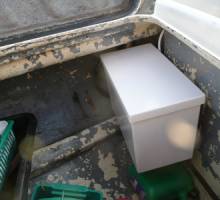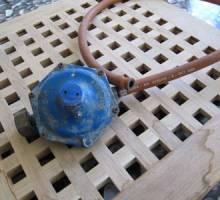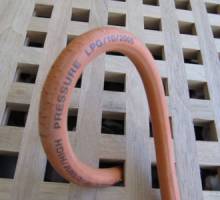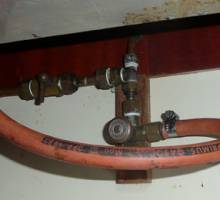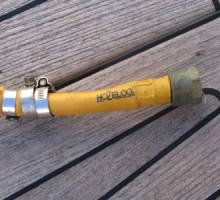
How to avoid blowing your boat up!
As yacht brokers we often get asked about gas systems on boats, it’s one of those things that often comes up when a used boat is surveyed. We all know just how dangerous and fatal gas explosions can be so Amina Cleal from Boatshed Plymouth took the opportunity to find out a bit more about this potentially lethal subject from South West marine gas engineer Tim Beck.
Tim has been doing some work on the boat which may well have been the inspiration for Boatshed.com itself, Neil and Mandy Chapman, the founders of Boatshed currently have their Rebel 41 Ketch moored in Plymouth’s Yacht Haven Marina and Tim has been overhauling the gas system on board. He came into the office with a stash of dodgy pipes and regulators, thankfully none from the Boatshed boat to explain what owners can do for themselves to protect their boat and those aboard her.
What you can do
Tim, who is Gas safe registered, advises you complete a thorough check of the system at least once a year, most of this is just a visual inspection but might just save yours or someone else’s life.
Start with the Gas locker itself.
This should be a dedicated locker with a drain which leads overboard to allow any gas which leaks from the bottles to pass harmlessly out of the boat.
The flexible hose attached to the gas bottle should be replaced every five years, visually the pipe may look ok but LPG is corrosive and eats away at the inside of the pipes so check the date stamped on the hose itself and if it is out of date the safest thing to do is replace it. Rubber hoses can also perish so have a good close up look at them to check for any signs of damage and replace if you spot anything, the small cost of a new piece of hose is nothing compared to the consequences of an explosion.
The regulator should be replaced every 10 years, again they may look fine but the oily residue produced by the corrosive action of the LPG bungs them up. The date is normally stamped on the regulator nut.
Check that all the hose and regulator fittings are secure.
Check that the bottles are secure, many production boats have dedicated lockers in which the bottles fit snugly and can’t move around much, if your locker is much bigger then the bottles should be strapped in place to ensure that in rough seas they cannot tip enough to allow liquid gas into the system.
Ideally nothing else should be stored in the gas locker but Tim knows we all put other things in there too. He says most other fluids would probably be alright but under no circumstances should petrol ever be stored with the gas, generally the safest place to store petrol on most boats is in the anchor locker if it drains overboard. The other thing to ensure is that all the other bits and bobs in the locker can’t move about and damage or knock the hoses and regulators.
Inside the boat
Once you’ve checked the gas locker move on to the pipe leading from there to the first (or in most cases the only) appliance. Rigid pipe does not need to be replaced at set intervals like flexible hoses so just take a good look at the pipe to make sure it isn’t corroded or pitted and that there are no signs of wear or chafe, this is most likely to occur where the pipe passes through a bulkhead – inevitably the trickiest bit to check! Also check that the pipe is secure and not able to move.
Somewhere in the run of pipe, close to the appliance there should be an isolation valve, this should be a quarter turn ball valve rather than a needle valve so that in an emergency you can turn the gas supply off very quickly. Bear this in mind if you need to site a new isolation valve, potentially you need to get to it even if the appliance is on fire.
For all gimballed appliances there needs to be an armoured hose leading from the appliance to the fixed pipe. Again these are date stamped as they need to be changed every 5 years but it’s really important to check these regularly. Boat cookers often have sharp corners and are designed to move providing ideal conditions to damage the gas hose.
Next check the appliance itself. Make sure it’s clean and check for corrosion, if you are concerned about the appliance it might just be worth getting an expert to check it if not proceed to the next step and light it. The flame should never lift off the burner and there should be no sign of yellow in the flame. With a cooker don’t forget to check the grill and oven burners if it has them.
All appliances should be fitted with flame failure devices, these ensure that the gas supply shuts off automatically if there is no flame. Check each burner one at a time, light it and let it get hot then turn the gas off and wait for around 30 seconds. You should here a click. Then turn the gas switch back on at this point no gas should come out, you can check this very carefully with a lighted match but make sure you are ready to turn the supply off if necessary.
And that’s the year’s gas check completed, doesn’t sound too onerous considering the danger we might otherwise be putting ourselves and crew into.
You can check for leaks in the system anytime you are onboard overnight. Last thing turn the gas off at the bottle. In the morning go through the normal procedure for lighting the appliance. There should be enough gas in the system to allow you to do this and support a flame for a short time. The nearer the appliance is to the gas bottle the less time you will have. If no gas comes out of the system the chances are that you have a leak somewhere. The gas would escape eventually so after a couple of weeks this would not be unusual but overnight this would definitely be a cause for concern. This is one check I’m going to carry out very often as it sounds so simple and yet could save our lives.
Tim also has a few words of wisdom for when you are using gas onboard:
Always make sure you have adequate ventilation
Never use cooker as a source of space heating
Always turn the gas off at the bottle when you leave the boat
If you have any doubts about your gas system don’t use it.
Get an expert in to install and check the system.
So I asked Tim the all important question; How much?
To replace the whole gas installation on our Sigma 33 and reinstall our existing cooker £260
To replace the flexible hose in the gas locker and the armoured hose at the back of the cooker £80
Well that’s a lot less than my insurance excess so I reckon it’s well worth doing.
Tim is based in Saltash on the banks of the river Tamar and so is ideally placed to serve the South West of England travelling around Cornwall and Devon. He is well known in the main Plymouth Marinas and yards but covers as far west as Falmouth, as far East as Torquay and has done some work in the Bristol area too. If Tim doesn't cover your area he suggests you take a look at the links page of your local Boatshed broker or the gas safe website.
To contact Tim click here


